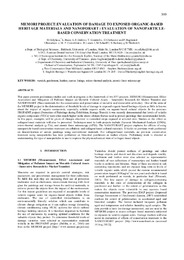| dc.contributor.author | Odlyha, M. | en |
| dc.contributor.author | Bozec, L. | en |
| dc.contributor.author | Dahlin, E. | en |
| dc.contributor.author | Grontoft, T. | en |
| dc.contributor.author | Chelazzi, D. | en |
| dc.contributor.author | Baglioni, P. | en |
| dc.contributor.author | Bonaduce, I. | en |
| dc.contributor.author | Colombini, M. P. | en |
| dc.contributor.author | Larsen, R. | en |
| dc.contributor.author | Scharff, M. | en |
| dc.contributor.author | Hackney, S. | en |
| dc.contributor.author | Thickett, D. | en |
| dc.date.accessioned | 2013-02-15T07:10:43Z | en |
| dc.date.available | 2013-02-15T07:10:43Z | en |
| dc.date.issued | 2012-10-29 | en |
| dc.identifier.issn | 2047-4970 (Print) | en |
| dc.identifier.uri | http://hdl.handle.net/10797/6115 | en |
| dc.description.abstract | This paper presents preliminary studies and work in progress in the framework of two FP7 projects: MEMORI (Measurement, Effect Assessment and Mitigation of Pollutant Impact on Movable Cultural Assets - Innovative Research for Market Transfer) and NANOFORART (Nano-materials for the conservation and preservation of movable and immovable artworks). One of the aims of the MEMORI project is the determination of threshold levels of damage to exposed organic-based heritage objects as little is known about the impact of organic compounds, especially volatile organic acids, on organic-based cultural objects. In the previous PROPAINT project (Protection of Paintings during Exhibition, Storage Transit) it was recently demonstrated that levels of volatile organic compounds (VOCs) were often much higher in the micro-climate frames used to protect paintings than recommended levels. In this paper, examples will be given of changes observed in varnished strips exposed at selected sites. Studies on the effect on collagen-based materials will also be presented. Techniques used in both projects include Dynamic Mechanical Analysis (DMA), micro-thermal analysis (μ-TA), and atomic force microscopy (AFM). The NANOFORART project explores the effects of using nanoparticle-based conservation treatment on cellulosic and collagen-based cultural materials. It builds on previous work performed on deacidification of canvas paintings using conventional materials. For collagen-based materials, no previous conservation treatment using nanoparticles has been performed on historical parchment or leather objects. Preliminary work is directed at understanding the type of nanoparticles to use to improve the physicochemical state of collagen-based objects. | en |
| dc.description.sponsorship | Dept. of Biological Sciences, Birkbeck, University of London, Malet St., London WC1E 7HX, UCL Eastman Dental Institute, 256 Gray's Inn Road London, WC1X 8LD, NILU-Norwegian Institute for Air Research Kjeller, Norway, Dept. of Chemistry, University of Florence, Department of Chemistry and Industrial Chemistry, University of Pisa, School of Conservation, Esplanaden 34 DK-1263 Copenhagen, Tate Conservation Dept Millbank, London SW1P 4RG, English Heritage, 1 Waterhouse Square138 London EC1N 2ST | en |
| dc.language.iso | eng | en |
| dc.publisher | Multi Science Publishing | en |
| dc.relation | info:eu-repo/grantAgreement/EC/FP7/265132 | en |
| dc.relation.ispartof | International Journal of Heritage in the Digital Era, Volume 1, Supplement 1, Pages 319-324 | en |
| dc.rights | info:eu-repo/semantics/openAccess | en |
| dc.subject | Varnish | en |
| dc.subject | Parchment | en |
| dc.subject | Leather | en |
| dc.subject | Canvas linings | en |
| dc.subject | Micro-thermal analysis | en |
| dc.subject | Atomic force microscopy | en |
| dc.title | Memori Project: Evaluation of Damage to Exposed Organic-Based Heritage Materials and Nanoforart: Evaluation of Nanoparticle-based Conservation Treatment | en |
| dc.type | info:eu-repo/semantics/conferenceObject | en |
| dc.identifier.doi | 10.1260/2047-4970.1.0.319 | en |
